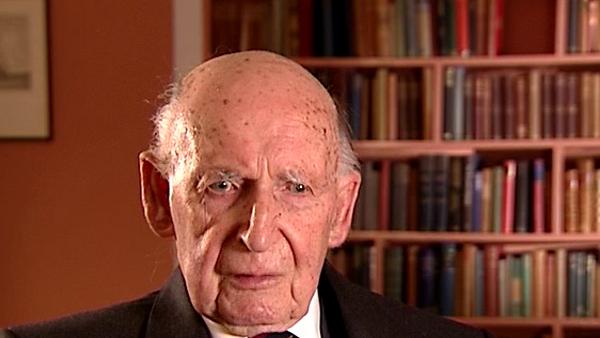NEXT STORY

Work on cosmic ray showers and an influx of refugees from Europe
RELATED STORIES

NEXT STORY

Work on cosmic ray showers and an influx of refugees from Europe
RELATED STORIES


|
Views | Duration | |
|---|---|---|---|
| 1. Early life in Oldland Common | 2 | 875 | 03:42 |
| 2. Secondary school and the lecture that changed my life | 1 | 630 | 04:54 |
| 3. Cricket and doing research on the conductivity of thin films of... | 267 | 07:02 | |
| 4. 'I'd really rather work with Blackett' | 235 | 06:37 | |
| 5. How I came to work with Douglas Hartree | 220 | 04:12 | |
| 6. Patrick Blackett takes over from Lawrence Bragg at Manchester | 203 | 04:22 | |
| 7. Patrick Blackett and work with cloud chambers | 221 | 02:51 | |
| 8. Clearing the cloud chambers | 163 | 01:59 | |
| 9. Werner Heisenberg and the theory of high energy particles | 1 | 430 | 03:03 |
| 10. Work on cosmic ray showers and an influx of refugees from Europe | 181 | 03:51 |

Blackett had arranged a weekend conference and this weekend conference was attended by, I think, some of the most eminent physicists in the world. At that time, Europe was becoming extremely disturbed and the refugees, both from Germany and from Italy were pouring through Blackett's department, and that was another great privilege of being in Manchester at that time. One met so many people, either in passage or they stayed for a long time and worked with Blackett.
Now, this weekend conference... I particularly remember Werner Heisenberg. Heisenberg was one of the great physicists in Germany who came from Leipzig, well-known for his uncertainty principle, and the whole of that weekend was occupied by the discussion of whether the conventional theory of high energy electrons, high energy particles was correct or whether a new particle was involved. Yukawa, a Japanese theorist had postulated that there was a heavy electron, I think then about 180 times the mass of the normal electron, which we then called a mesotron.
Well, for clarity it soon became a meson, or mason, and there are now large numbers of mesons known in particle physics, but during that weekend conference with Heisenberg believing completely in Yukawa's theory that we were studying not high energy electrons impacting on the lead plate or on the atmosphere, but one of the heavy electrons that became the matter for dispute. And gradually during that weekend I remember Blackett's view beginning to change, and before the end of the Sunday, he had been finally convinced by Heisenberg in particular and by the other physicists there that the theory was correct, and that we were dealing with a new type of particle. That may sound very odd nowadays, when there are hundreds and thousands of new particles, but one must remember that in those days we're dealing with the proton, the positive and negative electron, the neutron which had just been discovered by Chadwick. And this was remarkable, that we were adding to it a new particle which was about 180 times the area of an electron.
Bernard Lovell (1913-2012), British radio astronomer and founder of the Jodrell Bank Observatory, received an OBE in 1946 for his work on radar, and was knighted in 1961 for his contribution to the development of radio astronomy. He obtained a PhD in 1936 at the University of Bristol. His steerable radio telescope, which tracked Sputnik across the sky, is now named the Lovell telescope.
Title: Werner Heisenberg and the theory of high energy particles
Listeners: Megan Argo Alastair Gunn
Megan Argo is an astronomer at the University of Manchester's Jodrell Bank Observatory researching supernovae and star formation in nearby starburst galaxies. As well as research, she is involved with events in the Observatory's Visitor Centre explaining both astronomy and the history of the Observatory to the public.
Alastair Gunn is an astrophysicist at Jodrell Bank Observatory, University of Manchester. He is responsible for the coordination and execution of international radio astronomical observations at the institute and his professional research concerns the extended atmospheres of highly active binary stars. Alastair has a deep interest and knowledge of the history of radio astronomy in general and of Jodrell Bank in particular. He has written extensively about Jodrell Bank's history.
Tags: Europe, Germany, Italy, Leipzig, Patrick Blackett, Werner Heisenberg, Hideki Yukawa, James Chadwick
Duration: 3 minutes, 3 seconds
Date story recorded: January 2007
Date story went live: 05 September 2008